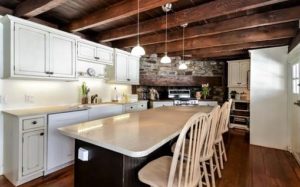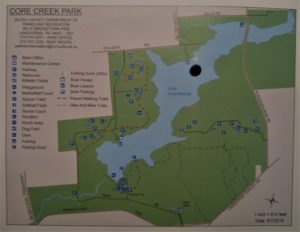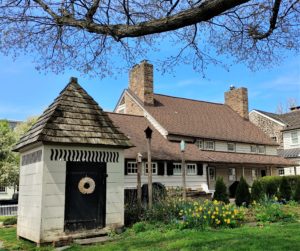Newtown’s uniquely historic Bird in Hand is up for sale.
Mary Anne and I were newlyweds in the late 1970s when we offered to buy a post-Colonial townhome on Penn Street in Newtown. It needed some TLC but not much. We liked the cozy neighborhood dating back to the 1700s two blocks in from the State Street business district. The asking price was a doable 60K.
Unfortunately, the property came off the market at the last minute. Drat! We continued strolling the borough, looking for another listing and lingering beside the white picket fence of Bird in Hand two blocks from the Penn property. There we admired the home’s perennial flower gardens where a bit of the American Revolution played out. Today the impeccably-preserved, two-story residence is up for sale in a hot Newtown real estate market. Unfortunately, we’d have to dig too deep for such a magnificent residence listed at $975,000.


The property offers much: 5 large bedrooms, 5 full baths, 7 fireplaces, chef’s kitchen, detailed millwork, pumpkin pine wide plank flooring, high beamed ceilings and 3,200 square feet of living space. But wait! There’s more. It’s got history. Lots of history. That’s where I come in as a wish-I-could-be a buyer.
Off the top, Bird in Hand is the oldest frame building standing on its original site in Pennsylvania. Shadrack Walley built it in 1686 at 111 State St. That was just 4 years after William Penn stepped off the boat to found his new colony. Shadrack’s home became the Old Frame Tavern in 1726 under George Welsh who expanded it while adding projecting eves and a hipped roof. As the borough’s first and largest ale house, it thrived for decades. In 1817, Asa and Tamar Carey bought and renamed it after an olde English proverb – “A bird in the hand is worth two in the bush.” Edward Hicks, Newtown artist famous for his “Peaceable Kingdom” series, painted a colorful sign identifying Bird in Hand.
Of most interest to me is what occurred there during the American Revolution. After George Washington crossed the Delaware on Christmas 1776 to attack Trenton and capture 1,000 Hessian soldiers, he marched back to Newtown with enemy officers, quartered at Bird in Hand. From his headquarters in a nearby widow’s home (now a gas station), George dispatched a letter to Congress in Philadelphia to announce his stunning victory.


Nine months later the British counter-attacked, invading Philly from the south after defeating Washington at Brandywine. His remaining 10,000-man army retreated to Valley Forge for the winter. Back in Newtown, a beehive of tailors inside Bird in Hand worked to stitch wool into uniforms for Valley Forge. The wool came from Joseph Jenk’s fulling mill on Core Creek in Middletown a few miles away. The troops desperately needed those uniforms in the deep freeze of February 1778.
In Philadelphia, British Gen. William Howe and his 15,000-man occupying force were determined to suppress any efforts in Bucks to aid Washington. Howe commissioned Loyalist Richard Hovenden, a Newtown native, to organize a 30-man swift-strike cavalry and 40-man infantry based in Torresdale. Uniformed in emerald green jackets and high helmets, the cavalry presented an intimidating front in “shock and awe” tactics favored by Howe.
On the night of Feb. 18, 1778, the unit headed for Jenk’s mill. Taken by surprise, troops guarding the factory surrendered without firing a shot. Hovenden confiscated the wool and burned the mill. He then struck west on Fulling Mill Road to target Bird in Hand. When the cavalry came into view, a young sentry in a second-floor window fired a warning shot. Major Francis Murray and 16 pickets took cover behind a stone wall and directed rifle fire at the enemy. Before they could reload, Hovenden brought 70 guns to bear. It was no contest. Five Continentals were shot to death including the sentry. Four others survived grave wounds. It was a greater toll than suffered by Washington’s army in Trenton. The enemy swarmed the inn, capturing Major Murphy and 10 others plus the tailors. News of the skirmish heartened the British, noting the 2,000 yards of cloth seized was “enough for 500 men.” A Loyalist city newspaper boasted, “Too much commendation cannot be given to this gallant action.”
In the months to come, Hovenden intercepted 150 oxen bound for Valley Forge and rerouted them to Howe. The captain also forayed into Bristol where he captured Col. Joseph Penrose and officers of the 10th Pennsylvania Regiment.

Though operations were going well to quell local resistance, setbacks elsewhere caused Howe to abandon Philadelphia in June 1778. Hovenden moved south with them and was captured in Yorktown, Va. He subsequently retired to Canada. Major Murray survived two years of imprisonment on Long Island, returned to Bucks and became a county commissioner.
Today, Fulling Mill Road disappears under Lake Luxembourg which covers the foundation of Jenk’s mill. Bird in Hand perseveres as a look back at history – now for sale.
***
Sources include “The Loyalist Raid on Newtown: The Consequences of Being Surprised” by Andrew A. Zellers-Frederick published on March 5, 2018 in the Journal of the American Revolution, and “Colonial Inns and Taverns of Bucks County” by Marie Murphy Duess published in 2007. Information on the listing of Bird in Hand can be found on the web at https

